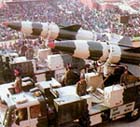
Opinion/Gaurav Kampani
ISRO"s space programme is
saddled with the highest launch
failure rate in the world'
 A more realistic study carried by Bhabani Sen Gupta at the Centre for Policy Research pegged the total cost of a first and second generation Indian deterrent at about $ 20 billion (1981 figures). This study, of course, accounted for investments that would be necessary to develop, maintain, replace and ultimately retire the entire nuclear weapons related complex over two decades.
A more realistic study carried by Bhabani Sen Gupta at the Centre for Policy Research pegged the total cost of a first and second generation Indian deterrent at about $ 20 billion (1981 figures). This study, of course, accounted for investments that would be necessary to develop, maintain, replace and ultimately retire the entire nuclear weapons related complex over two decades.
But even these are conservative estimates. For the costs related to the secure storage and disposal of fissile material, overall management of the nuclear weapons complex, security and secrecy and, more importantly, the legacies of the weapons complex -- waste management, environmental remediation, and the potential costs of nuclear accidents -- could well the push the figure above the $20 billion mark.
To put this in perspective, it not only exceeds the total capital expenditures on the armed forces for the last five years, but also the entire Indian defence budget for the fiscal year 1997-98 by nearly two times! Already India's armed services are reeling under the impact of shrinking budgets and reduced capital outlays. For nearly a decade, fiscal constraints have brought all defence modernisation plans to a halt and investments in a nuclear arsenal would further erode India's conventional posture.
The current squeeze on defence spending is likely to continue until the end of this century. It stems from the critical need to restore fiscal balance in the economy. This in turn holds the key to greater public savings, lower interest rates, and higher growth. Any further increase in the central government's deficit is likely to push the economy into a high-inflation and low growth trajectory. Worse, it could trigger an internal debt trap.
The 1995 World Bank Country Study on India indicates that 70 percent of the central government's tax revenues are now used to service internal debt, which as a percentage of GDP has jumped from 22 percent in 1980-81 to nearly 56 percent in 1995-96. Given these fiscal constraints, increase inIndia's defence spending could only be financed in three ways -- budget deficits, increased internal and external borrowings or a diversion of resources from other competing sectors of the economy. All three courses would spell disaster for the economy.
Those who cavalierly dismiss the potential cost of economic sanctions ought to take a harder look at India's predicament. India needs nearly $ 200 billion in infrastructural investments alone to sustain a growth rate of seven per cent over the next decade. Investments of that magnitude cannot be scraped together from internal sources for the simple reason that public savings are now approaching zero.
With only 10 per cent of these investments slated to come from the private sector, India's economic development now substantially depends on inflows of foreign capital. Further, since India sees capital account convertibility as a medium term objective, the country will need to rely on foreign direct investment and multilateral agency loans to meet its demands for capital, for the foreseeable future. Both are unlikely to materialise in the event of economic sanctions.
Also, the ability to field long-range strategic strike weapon systems is central to the creation of a nuclear deterrent. Unfortunately, as a SIPRI study points out, 'India's strategic space, long-range strike and power projection programs show every sign of having been frozen or set back.' An analysis of India's strategic programmes -- long range missiles, nuclear submarines, and space launch vehicles -- reveals the R&D labs have been unable to overcome the problems related to design, project management, and systems integration. Although Indian military technology has crossed important thresholds, the "anticipated momentum" seems nowhere in sight.
For instance take the ATV or nuclear submarine, which is potentially an invulnerable platform for nuclear weapons. After two decades and $ 285 million in sunk development costs, the project has been frozen. The reason: reactor failures, "integration and fabrication" problems, and safety leaks. The much vaunted Agni also suffered launch and staging failures in two out of three tests. For all the Defence Research and Development Organisation's boasts about "self reliance," it took a Russian consultant to identify the software-induced failure during the second test. There is evidence to suggest that some of the critical technologies -- re-entry shields and inertial guidance systems, which were validated during the third test --had German parentage. In any case, for operational reasons no military would want a missile like Agni, which is a hybrid of solid and liquid fuel boosters.
It is not just the military. Civilian programmes are equally plagued by failures. ISRO"s space programme is saddled with the highest launch failure rate in the world. If sanctions are imposed, the foreign content in ISRO's satellites and launch vehicles would lead to time and cost overruns. Worse, sanctions could be used to block India out of the global space market.
Gaurav Kampani, continued
Tell us what you think of this article
|





